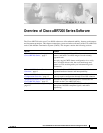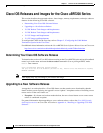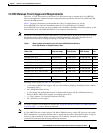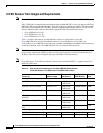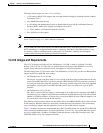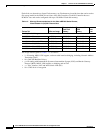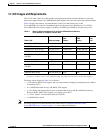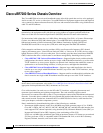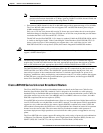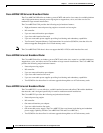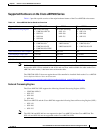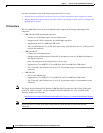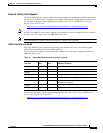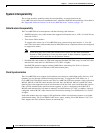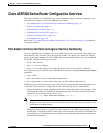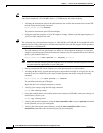
1-9
Cisco uBR7200 Series Universal Broadband Router Software Configuration Guide
OL-2239-05
Chapter1 Overview of Cisco uBR7200 Series Software
Cisco uBR7200 Series Chassis Overview
Note Cisco 6 MHz products can be used in 8 MHz cable plants. The products, however, operate at a
maximum downstream bandwidth of 27 Mbps, ignoring 2 MHz of available channel width, and
limiting upstream channel choices to the range below 42 MHz.
• Downstream 8MHz channels in the 85-to-860 MHz range with an upstream range of 5 to 65 MHz.
The Cisco MC16E cable interface line card supports PAL and SECAM channel plans using an
8MHz modulated signal.
PAL uses a 625-line scan picture delivered at 25frames per second where the color carrier phase
definition changes in alternate scan lines. SECAM uses an 819 line scan picture that provides better
resolution than PAL's 625-line and NTSC's 525-line.
The MC16E uses the EuroDOCSIS J.112 (Annex A) standard, CableLabs ECR RFI-R-98036, which
is similar to the Digital Audio Video Council/Digital Video Broadcast (DAVIC/DVB) ITUJ.83
AnnexA physical layer. Cable companies can support data, voice, and video services with
DOCSIS-based CMs or set top boxes (STBs) that contain integrated EuroDOCSIS modems.
Caution The MC16E supports only AnnexA operation and should not be used in production cableplants that
support a 6MHz channel plan.
Note The difference between DOCSIS and EuroDOCSIS is at the physical layer. EuroDOCSIS support
requires the Cisco MC16E cable interface line card, appropriate upconverters that support an 8MHz
PAL or SECAM channel plan, appropriate diplex filters, and EuroDOCSIS-based CMs or STBs.
The DOCSIS Radio Frequency (RF) specification defines the RF communication paths between the
CMTS and CMs (or CMs in STBs). The DOCSIS RF specification defines the physical, link, and
network layer aspects of the communication interfaces. It includes specifications for power level,
frequency, modulation, coding, multiplexing, and contention control. Cisco offers products that support
all DOCSIS error correction encoding and modulation types and formats, and that support DOCSIS
Annex B or EuroDOCSIS Annex A operations.
Cisco uBR7200 Series Universal Broadband Routers
The Cisco uBR7200 series universal broadband routers are based on the Data-over-Cable Service
Interface Specification (DOCSIS) standards. Each is designed to be installed at a cable operator's
headend facility or distribution hub and to function as the cable modem termination system (CMTS) for
subscriber-end devices such as the Cisco uBR905 and Cisco uBR925 cable access routers, and other
DOCSIS-compliant CMs and set-top boxes (STBs).
Cisco uBR7200 series universal broadband routers allow two-way transmission of digital data and Voice
over IP (VoIP) traffic over a hybrid fiber-coaxial (HFC) network. For cable plants not fully upgraded to
support two-way cable transmission, the routers support DOCSIS-compliant telco return, where the
cable modem's return path to the CMTS uses a dial-up telephone line connection instead of an upstream
channel over the coaxial cable. The telco-return delivery mechanism enables cable operators to
accelerate deployment of high-speed data services before the cable systems are upgraded to two-way
plants.
The Cisco uBR7200 series routers support IP routing with a wide variety of protocols and combinations
of Ethernet, Fast Ethernet, Gigabit Ethernet, serial, High-Speed Serial Interface (HSSI), Packet over
SONET (POS) OC-3 and OC-12c, and Asynchronous Transfer Mode (ATM) media.



